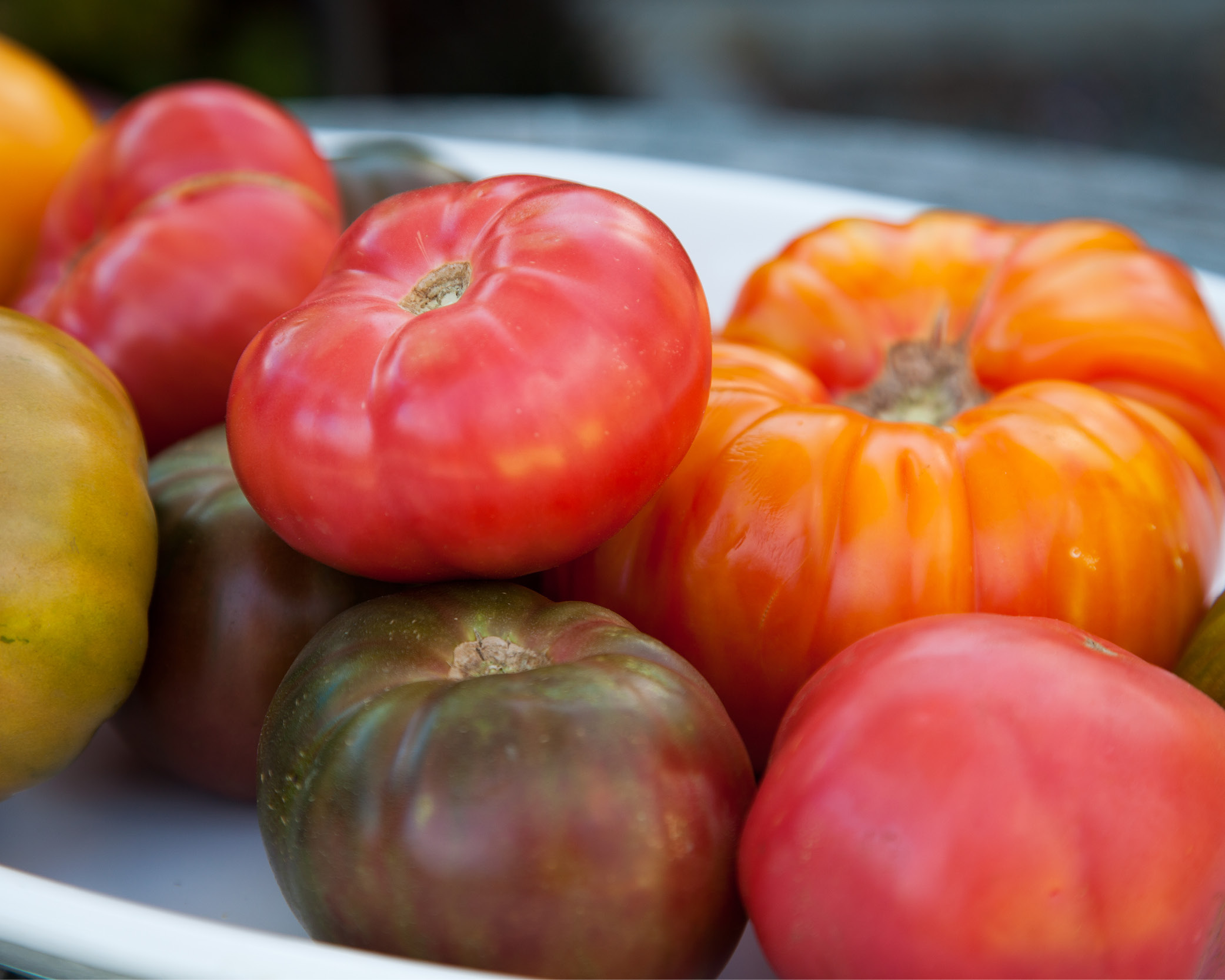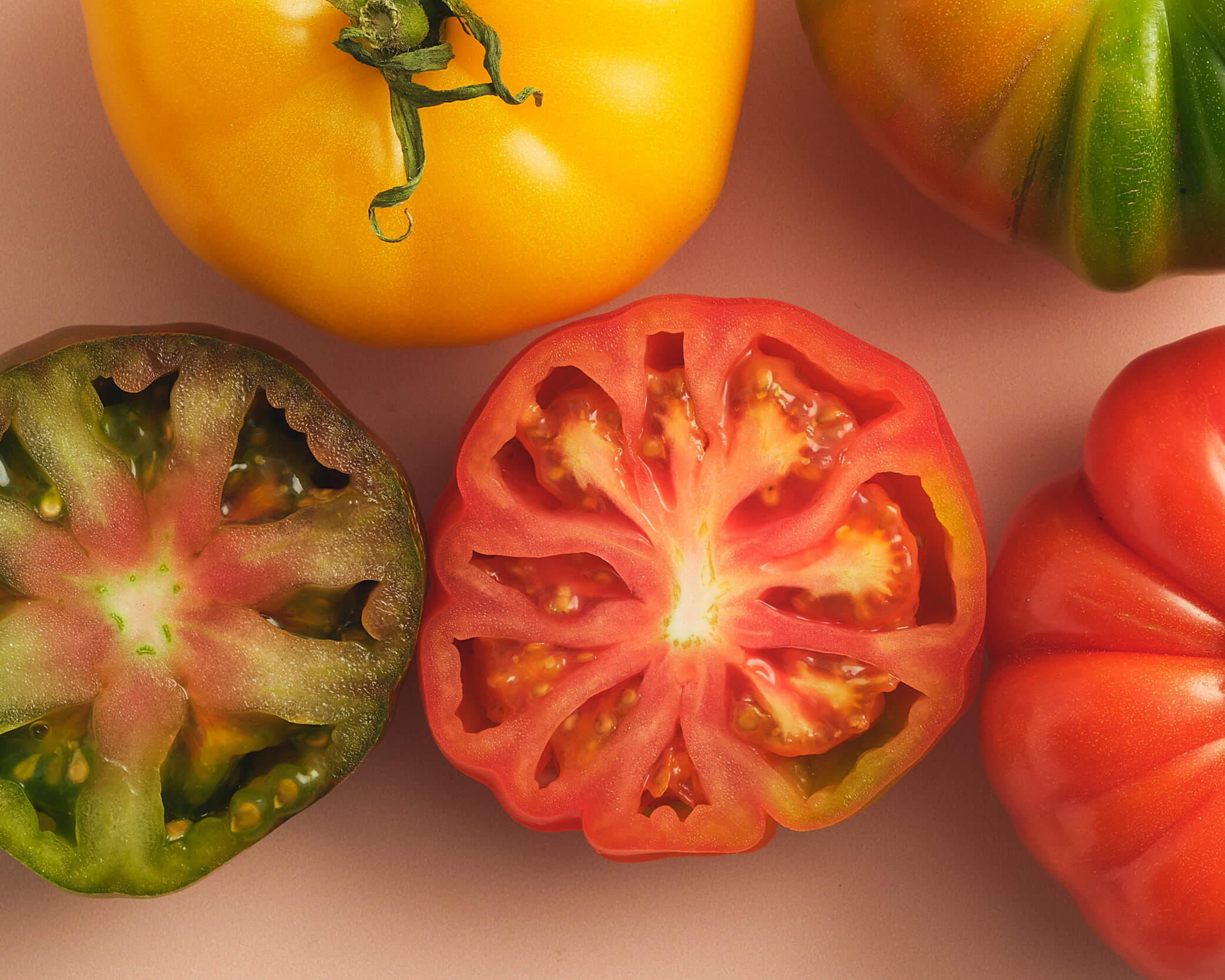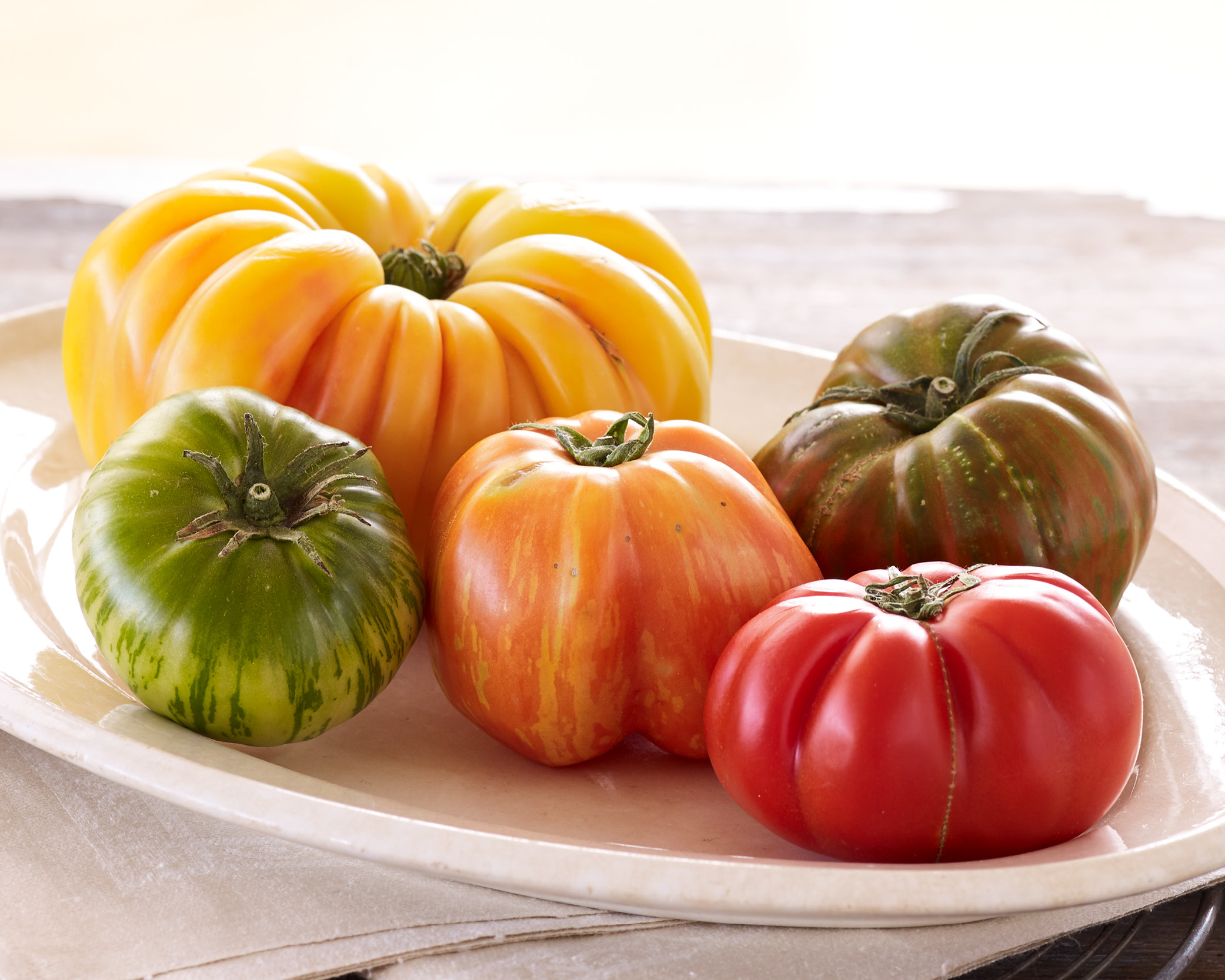
Lumpy, bumpy, and collaged with color. No, I’m not talking about the Pike Place Gum Wall. Thankfully, I’m referring to something vastly more appetizing: heirloom tomatoes. Late summer hits, and these juicy gems are just what I’m craving. One of the best meals I’ve ever eaten was a beefy heirloom tomato the size of my face—served like a steak with a drizzle of olive oil and sprinkle of flaky sea salt. Thank you, San Fermo, for converting me to the heirloom cause.
These striking tomatoes come in all sorts of wacky shapes and unusual pigments, with flavor profiles as diverse as their looks. Some are sweet, others acidic, some sweet finishing acidic—you get the picture.
With all that variety, it’s easy to feel stumped in the produce department. Does green skin mean it’s underripe? Are smaller tomatoes more flavorful than big ones? And perhaps most importantly, why do they look like that? I sat down with our resident produce expert, Dino, to demystify these funky fruits.

The Heirloom Distinction
The term “heirloom” means that a seed hasn’t been modified for generations. It’s been passed down from grower to grower exactly as is to preserve specific characteristics—whether that be unique colors, textures, flavors, or other qualities.
“Heirlooms are like a vintage car,” says Dino. “They’re the original prized seed.”
Heirloom tomatoes develop drastically higher sugar levels than their conventional cousins, so they tend to taste much sweeter. Their thinner skin and fragile cell walls make them incredibly flavorful, but also prone to cracking and bulging (hello quirky forms!). Since they don’t hold up well to commercial shipping, you want to buy your heirlooms from local farmers or grocers for the highest-caliber fruit.
Peak Season
Heirloom tomatoes are available year-round, but especially exceptional ones hit the market for just 8-10 weeks out of the year—and the precise timeframe may surprise you! Local varieties from Oregon and Washington start arriving late July, and they’re available all the way through the end of October.
Move over, autumn apples! Even when the weather has turned a bit chilly, you can still savor the last flavors of summer with perfectly ripe heirloom tomatoes.
Flavor Factors
Both color and size can clue you in to how a tomato will taste. Oranges and yellows lean sweeter, reds tend to be more acidic, and greens land somewhere in between. So, if you choose a green-and-red fusion, you can expect a more savory, tangy-tasting tomato. On the other hand, an orange-and-yellow hybrid will deliver a mellower, smoother flavor.
When it comes to size, bigger generally means sweeter. In fact, that’s true of most fruit. When growing on the plant, the larger pieces of produce receive more nutrients and TLC, which translates to fuller flavor. So reach for the big guys if you want a sweet burst of deliciousness!
Choosing Your Heirloom
With such a broad heirloom assortment, how do you know which one to pick? “For me, it comes down to use,” says Dino. “If I’m making a burger, I want a tomato that’s large and covers the whole patty.”
Look for tomatoes with vibrant, opaque color and a firm feel that yields slightly under gentle pressure. If it’s too soft, it’s too ripe; too firm, and it’s not quite ready. “You really want to find that sweet spot,” says Dino.
Our Varieties and Grower
From moody purples to sunny yellows, grassy greens, and every shade in between—you’re bound to find an eye-catching heirloom at Metropolitan Market. We carry an extensive assortment, including Brandywine, Purple Cherokee, Black Krim, Evergreen, and Persimmon to name a few.
Dino’s personal favorite? The warm-hued German Stripe: “It’s almost like a rainbow of color in there—reds, yellows, and oranges. It’s a beautiful slice.”
For about 10 years, we’ve sourced our heirlooms from Frog Hollow Farm in Walla Walla. They don’t just grow 5, 10, or even 20 types of tomatoes—they grow hundreds of heirloom varieties on the farm. The land is situated on a riverbank, where plenty of organic matter enriches the soil. Dino believes that these favorable growing conditions are what make the Frog Hollow tomatoes taste so spectacular: “Sometimes I drive by the farm and I see that deep, dark earth, and I think to myself, ‘Man, that’s good soil!’”
Shelf Life and Storage
Heirloom tomatoes are delicate fruits bred for flavor over longevity. They’re ripe when you bring them home from the store, so try to eat them right away.
There’s just one cardinal rule when it comes to storing these sensitive fruits: do not keep them in the refrigerator—cold temperatures will ruin their precious texture and taste. Nobody likes a mushy, bland tomato! Instead, set them in a cool, dry place on your kitchen counter.

Tasty Tomato Recipes
In general, with any high-quality, peak-season produce, simple preparations are best. Sprinkling a bit of salt is a tried-and-true method for enhancing a tomato’s natural flavors.
“There’s nothing wrong with just eating a tomato with a little salt and olive oil,” says Dino. His go-to way to enjoy heirlooms is to plate them with burrata, basil, salt, and olive oil. The bright acidity and crisp texture of the tomatoes blend harmoniously with the creamy richness of fresh cheeses like burrata.
Tomatoes are an excellent addition to summertime toasts and salads. Give them a try in our Heirloom Tomato Salad with Crab Cakes, Heirloom Tomato and Prosciutto Caprese, or our Heirloom Tomato Salsa.
Toma-to-go
Swing by your local Metropolitan Market and scoop up a few heirloom tomatoes while they’re in season! Your taste buds will thank you.

